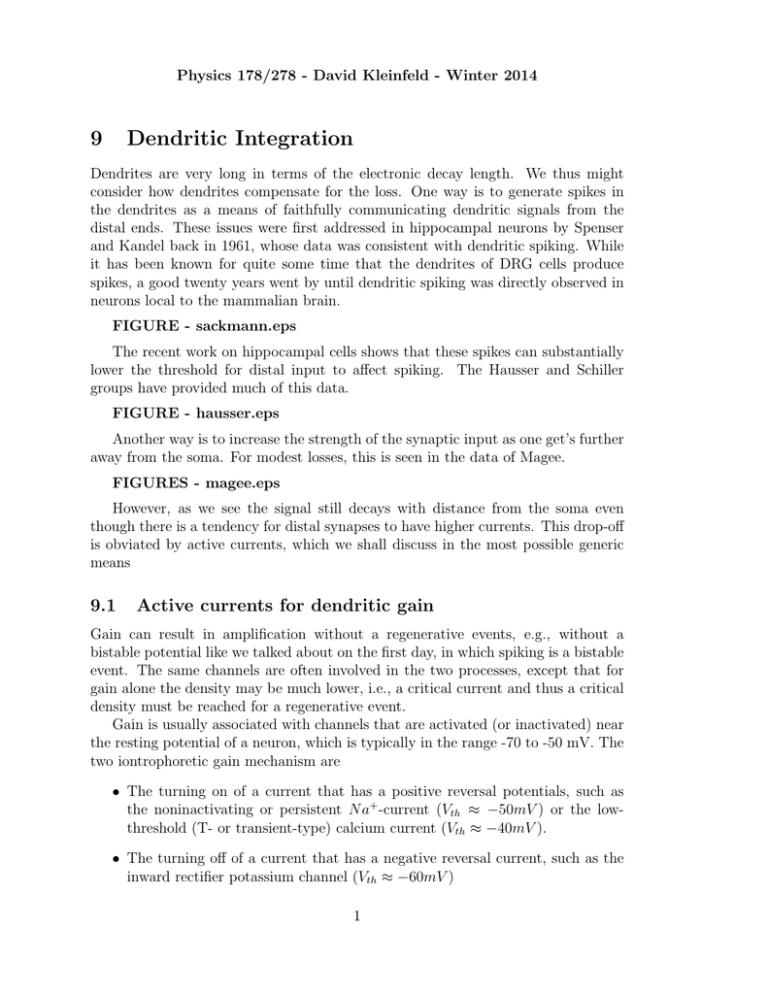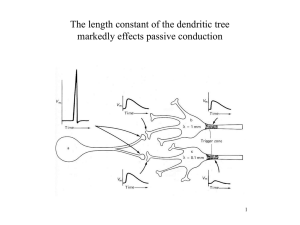9 Dendritic Integration
advertisement

Physics 178/278 - David Kleinfeld - Winter 2014 9 Dendritic Integration Dendrites are very long in terms of the electronic decay length. We thus might consider how dendrites compensate for the loss. One way is to generate spikes in the dendrites as a means of faithfully communicating dendritic signals from the distal ends. These issues were first addressed in hippocampal neurons by Spenser and Kandel back in 1961, whose data was consistent with dendritic spiking. While it has been known for quite some time that the dendrites of DRG cells produce spikes, a good twenty years went by until dendritic spiking was directly observed in neurons local to the mammalian brain. FIGURE - sackmann.eps The recent work on hippocampal cells shows that these spikes can substantially lower the threshold for distal input to affect spiking. The Hausser and Schiller groups have provided much of this data. FIGURE - hausser.eps Another way is to increase the strength of the synaptic input as one get’s further away from the soma. For modest losses, this is seen in the data of Magee. FIGURES - magee.eps However, as we see the signal still decays with distance from the soma even though there is a tendency for distal synapses to have higher currents. This drop-off is obviated by active currents, which we shall discuss in the most possible generic means 9.1 Active currents for dendritic gain Gain can result in amplification without a regenerative events, e.g., without a bistable potential like we talked about on the first day, in which spiking is a bistable event. The same channels are often involved in the two processes, except that for gain alone the density may be much lower, i.e., a critical current and thus a critical density must be reached for a regenerative event. Gain is usually associated with channels that are activated (or inactivated) near the resting potential of a neuron, which is typically in the range -70 to -50 mV. The two iontrophoretic gain mechanism are • The turning on of a current that has a positive reversal potentials, such as the noninactivating or persistent N a+ -current (Vth ≈ −50mV ) or the lowthreshold (T- or transient-type) calcium current (Vth ≈ −40mV ). • The turning off of a current that has a negative reversal current, such as the inward rectifier potassium channel (Vth ≈ −60mV ) 1 Without loss of generality, we consider the circuit equations for a cell with a leak current and a voltage activated persistent N a+ current. The leak current includes all the linear conductances and potentials, i.e., VLeak and GLeak . In EE-speak, this is the Thevnin equivalent circuit for all but the N a+ current. The N a+ current is assumed to be of the form IN a = GN a P (V )[V − VN a ], where P (V ) is a Boltzman activation curve of the form 1 P (V ) = (9.9) 1 + e−ze(V −Vth )/kB T The circuit equation for our model is C dV = GL [V − VLeak ] + GN a P (V )[V − VN a ] + Gsynapse Isynapse dt (9.10) At steady state, such as when the cell is at its’ resting potential with no synaptic currents, dV /dt = 0 and the steady state potential, denoted V ss , is found by solving the transendental equation 0 = GL [V ss − VLeak ] + GN a [V ss − VN a ] . 1 + e−ze(V ss −Vth )/kB T (9.11) For V ss << Vth , clearly V ss ' VLeak . We can linearize the response for voltage changes around V ss in the presence of a synaptic current −δI. We denote δv ≡ V − V ss , so that d(δV ) d[V − VLeak ] d (P (V )[V − VN a ]) = GL |V =V ss δv + GN a |V =V ss δv − δI. dt dV dV (9.12) Noting that C dP (V ) ze e−ze(V −Vth )/kB T ze = = P (V )[1 − P (V )] −ze(V −V )/k T 2 B th dV kB T (1 + e ) kB T (9.13) we have d(δv) C = dt " ! GL + GN a " = ze(V ss − VN a ) 1 + [1 − P (V )] P (V ss ) δv − δI kB T (9.14) ! # ss ze(VN a − V ) 1 − [1 − P (V ss )] P (V ss ) δv − δI. kB T GL + GN a # ss and at the new steady state δv = δI ss Na) GL + GN a 1 + [1 − P (V ss )] ze(V kB−V P (V ss ) T 2 (9.15) The key is the term that multiples GN a . If it is greater than zero the sodium conductance leads to a larger overall conductance and the cell is less sensitive to its inputs. On the other hand, if the term is less than zero, the overall conductance of the cell has gone down and a given input current will lead to a larger voltage change. This constitutes gain. It occurs when [1 − P (V ss )] ze(VN a − V ss ) >1 kB T (9.16) FIGURE - chapt-6-famous-model.eps For the case of V ss ∼ Vth , we have [1−P (V ss )] ∼ 1/2 and the inequality becomes ze(VN a − V ss ) >1 2kB T (9.17) which is expected to be true since (VN a − V ss ) ∼ 100mV ∼ 4 kBeT and z = 4 (more or less) for N a+ channels, so ze(VN a − V ss )/2kB T ∼ 8. We have gain as the channel is at the most sensitive point for increased opening with increased voltage. For the case of V ss << Vth , we can expand P (V ) to form the inequality ze(Vth − V ss ) ze(VN a − V ss ) >1 1+ kB T 2kB T " # (9.18) which is generally true as well. Thus the persistent N a+ channel leads to gain at low potential. Lastly, in the limit of V ss >> Vth , we can expand P (V ) to form the inequality ze(VN a − V ss ) >1 (9.19) kB T which is generally not true because of the exponential factor. Thus we see that gain exists only for a range of potentials not too far above Vth . When the negative conductance term with GN a gets big, the total conductance can go negative and we have action potential generation, as discussed previously. e 9.1.1 −ze(V ss −Vth ) kB T Evidence for gain by persistent N a+ currents Hirsch performed measurements of the post synaptic potential caused by a distal input as a function of the post-synaptic potential. Such a systematic exploration has the means to reveal an underlying gain mechanism. In particular, in the absence of gain the post synaptic potential will decreases as the cell is depolarized due to a drop in driving force, since the synaptic current is proportional to V − VN a+ . In practice, Hirsch observed gain that was dependent on a persistent-N a+ current. FIGURES - hirsch-gilbert.eps 3 9.1.2 Evidence for gain by inward rectifier K + currents Wessel performed measurements of the post synaptic potential caused by a distal input as a function of the post-synaptic potential. He found that the post synaptic potential increased as the steady-state voltage of the cell increased. Unlike the experiments of Hirsch, in this case the gain was caused by a turning off of a K + channel, the inward rectifier, so named since it’s threshold for activation is close to the reversal potential. The effect of turning off the channel is seen both in the conductance and the time constant of the cell. FIGURE - wessel-1.eps One consequence of the gain is that the response to successive EPSP’s increases in amplitude. FIGURE - wessel-2.eps 9.1.3 Evidence for gain by low threshold Ca2+ currents An independent mechanism for gain is localized spikes in specific dendrites. In particular, Llinas showed that the dendrites actually produce Ca+2 -based, as opposed to N a+ -based spikes. FIGURE - llinas.eps The issue of localization of calcium currents was first addressed in the imaging experiments of Ross, using a Ca2+ sensitive dye in slice. He found that selective regions of the distal dendrites could be excited, providing experimental evidence for the idea of localized activation in dendrites. FIGURE - imaging.eps FIGURE - ross.eps 4 Coincidence detection across dendritic compartments. (A) Reconstruction of a layer 5 pyramidal neuron; the locations of recording pipettes (soma, black; dendrite, red ) are depicted schematically. (B) Distal current injection of 1.1 nA in the shape of an EPSP (Istim, red ) evoked only weak somatic (black) depolarization (upper panel ). Threshold current injection (5 ms) into the soma (black) produced an AP that propagated back into the apical dendritic arbor (backpropagating action potential, bAP, red trace, middle panel ). Combination of somatic and dendritic current injection generates several somatic APs and a dendritic Ca2+ spike (backpropagating action potential–activated Ca2+ spike firing, BAC firing; lower panel ). The dashed line indicates the current threshold for a dendritic Ca2+ spike alone. (C) A dendritic Ca2+ spike was evoked by 2 nA current injection into the apical dendrite alone. Thus, the bAP reduced the threshold for dendritic Ca2+ spike by 0.9 nA.





